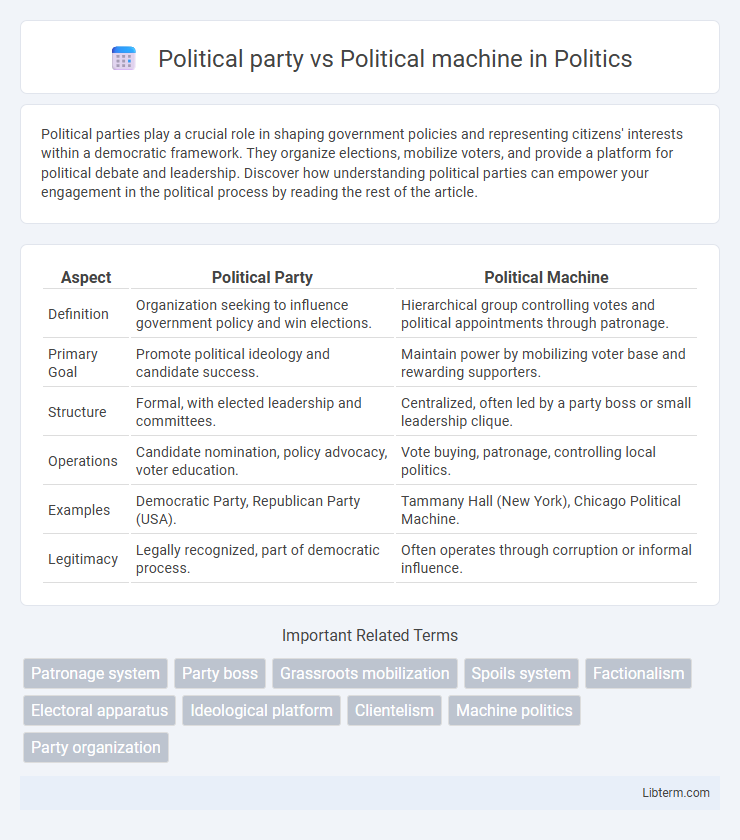Political parties play a crucial role in shaping government policies and representing citizens' interests within a democratic framework. They organize elections, mobilize voters, and provide a platform for political debate and leadership. Discover how understanding political parties can empower your engagement in the political process by reading the rest of the article.
Table of Comparison
| Aspect | Political Party | Political Machine |
|---|---|---|
| Definition | Organization seeking to influence government policy and win elections. | Hierarchical group controlling votes and political appointments through patronage. |
| Primary Goal | Promote political ideology and candidate success. | Maintain power by mobilizing voter base and rewarding supporters. |
| Structure | Formal, with elected leadership and committees. | Centralized, often led by a party boss or small leadership clique. |
| Operations | Candidate nomination, policy advocacy, voter education. | Vote buying, patronage, controlling local politics. |
| Examples | Democratic Party, Republican Party (USA). | Tammany Hall (New York), Chicago Political Machine. |
| Legitimacy | Legally recognized, part of democratic process. | Often operates through corruption or informal influence. |
Defining Political Parties and Political Machines
Political parties are organized groups that seek to influence government policy and gain political power through elections, representing broad interests and ideologies within a democratic system. Political machines are highly organized political organizations that often control local government through patronage, loyalty, and vote mobilization, frequently operating with centralized power and hierarchical leadership. While political parties function as vehicles for policy debates and candidate selection, political machines emphasize maintaining control over political appointments and voter turnout to sustain dominance.
Historical Origins and Evolution
Political parties originated as organized groups aiming to represent broad political interests and influence government policy through elections, tracing back to early democratic societies such as 18th-century Britain and the United States. Political machines evolved in the late 19th and early 20th centuries, particularly in urban America, as powerful, hierarchical organizations that controlled local politics through patronage, vote mobilization, and often corruption. The evolution of political machines highlighted the shift from ideological party platforms to pragmatic control mechanisms within party structures, shaping the dynamics of American urban politics.
Structural Differences Explained
Political parties function as formal organizations comprised of elected officials, party members, and supporters aiming to influence public policy through electoral processes. Political machines are hierarchical, centralized organizations that rely on patronage, loyalty, and control of resources to maintain power and secure votes within a specific locality. Structural differences include the formalized, broad-based approach of political parties versus the informal, tightly controlled, and often transactional nature of political machines.
Core Functions and Objectives
Political parties primarily focus on organizing voters, nominating candidates, and formulating policies to gain and maintain governmental power. Political machines operate as hierarchical organizations that control elections through patronage, mobilizing loyal voters by distributing jobs and favors. Both aim to influence political processes, yet parties emphasize broad governance and policy goals while machines concentrate on maintaining local control and loyalty.
Methods of Mobilizing Support
Political parties mobilize support through organized campaigns, voter registration drives, and policy platforms that appeal to broad demographics, focusing on ideology and public communication. Political machines, in contrast, rely heavily on patronage, exchange of favors, and ward-based networks to secure votes, often emphasizing loyalty over ideology. The effectiveness of a political machine lies in its ability to provide tangible benefits to constituents, while political parties seek to mobilize support through grassroots organizing and media outreach.
Influence on Governance and Policy
Political parties shape governance by formulating platforms, mobilizing voter support, and securing electoral victories to implement policy agendas across legislative and executive branches. Political machines exert influence through patronage systems, controlled voter blocs, and strategic distribution of resources to maintain power and direct local government decisions. While parties aim for broad ideological impact and policy development, machines prioritize maintaining localized authority often leading to governance driven by loyalty over merit.
Role in Election Campaigns
Political parties coordinate election campaigns by recruiting candidates, organizing rallies, and formulating policy platforms to appeal to a broad electorate. Political machines, often operating within parties, exert control through patronage and local influence, mobilizing voters with promises of jobs and services. The machine's grassroots network ensures high voter turnout and loyalty, significantly impacting election outcomes.
Advantages and Drawbacks
A political party organizes members around shared ideologies to influence government policy and elections, providing clear platforms and fostering democratic engagement, but risks internal factionalism and polarization. A political machine relies on hierarchical, patronage-based control to mobilize votes and maintain power, offering efficient voter turnout and resource distribution, yet often encouraging corruption and undermining democratic transparency. Both systems shape political landscapes but balance effectiveness against ethical and structural challenges.
Modern Examples and Case Studies
Modern political parties, such as the U.S. Democratic and Republican parties, organize campaigns, policy platforms, and voter outreach to influence elections and governance at multiple levels. Political machines, exemplified historically by New York's Tammany Hall and currently seen in some urban centers like Chicago, maintain control through patronage, voter mobilization, and sometimes corrupt practices to secure loyalty and electoral dominance. Case studies reveal that while political parties adapt through technology and evolving platforms, political machines exploit local networks and resources, making machine politics less prevalent but still impactful in specific regions.
The Future of Political Organizations
Political parties will increasingly integrate digital platforms and data analytics to enhance voter engagement and policy development, evolving into more transparent and responsive entities. Political machines, traditionally characterized by centralized control and patronage, face decline due to legal reforms and shifting public expectations favoring accountability. The future of political organizations emphasizes decentralized networks, grassroots mobilization, and technological innovation to sustain democratic participation and adapt to rapidly changing political landscapes.
Political party Infographic

 libterm.com
libterm.com